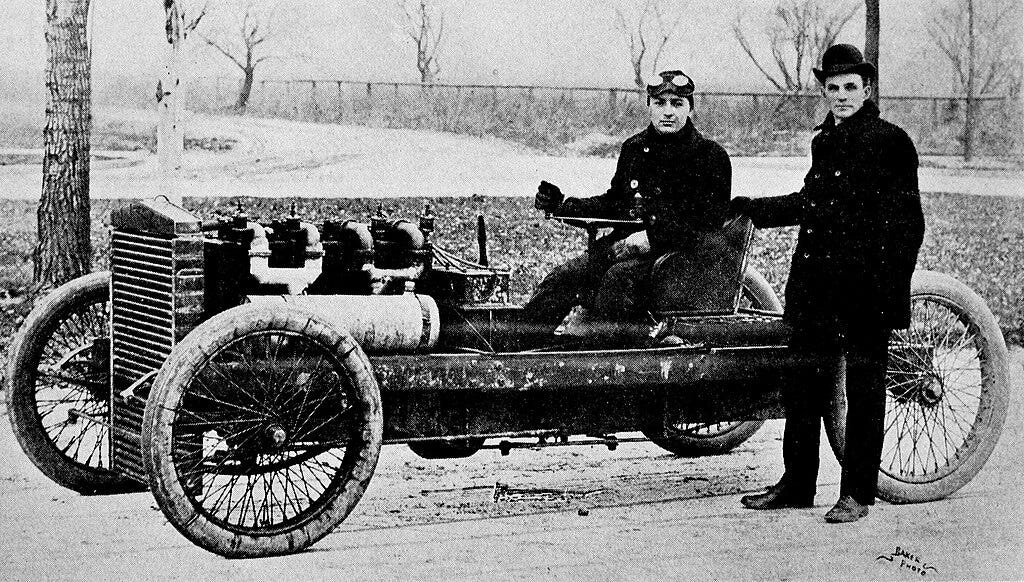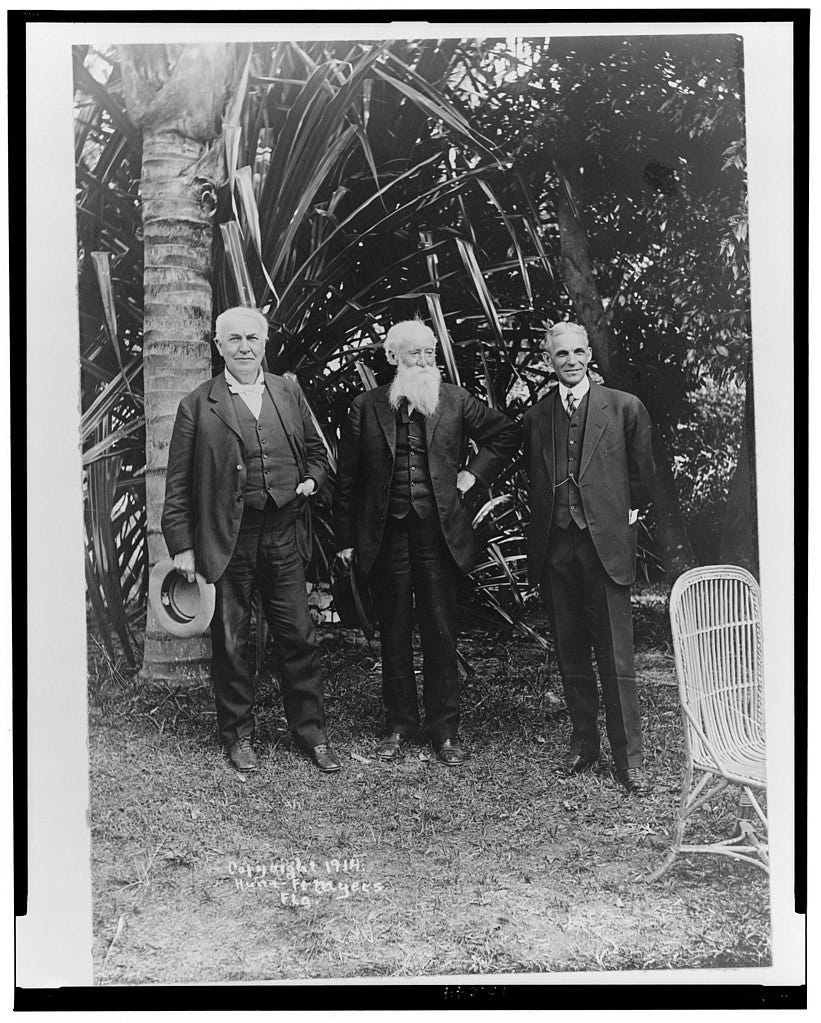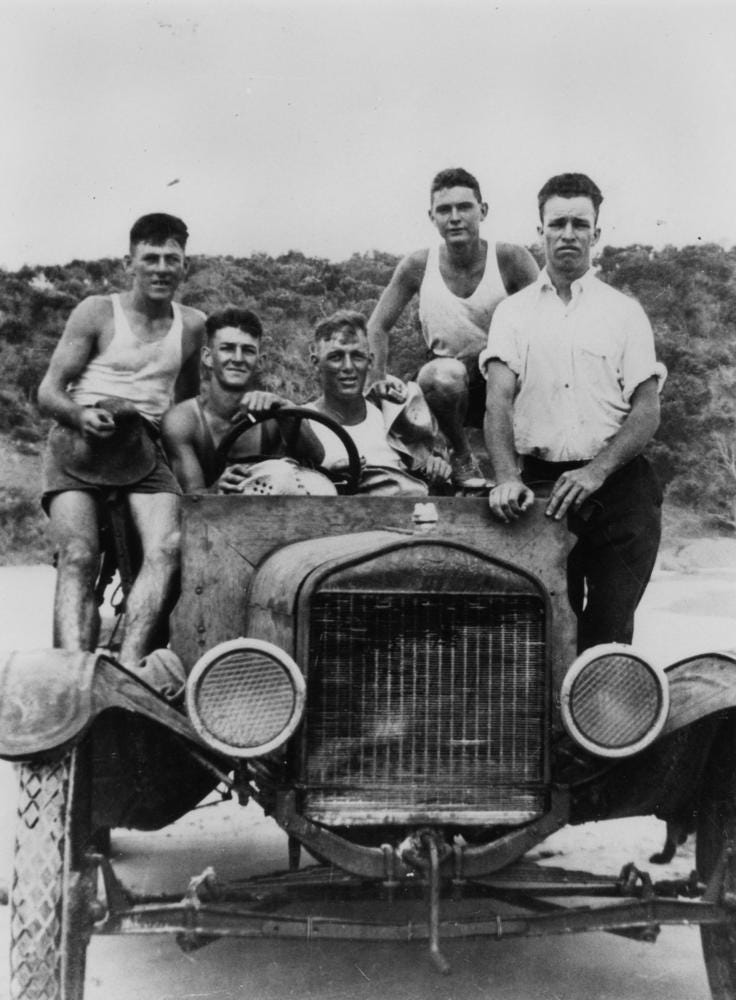How The Ford Model T Revolutionized Transportation
115 years ago this week, Henry Ford directed the final finishing touches on his first famous car
On August 12, 115 years ago, Henry Ford directed the final finishing touches on his first Model T. When the new car finally hit the streets of America’s cities two months later, it took the country and the world by storm and changed personal transportation forever.
Those streets weren’t empty: automobiles already existed before the Model T arrived on the scene. Some credit the German innovator Karl Benz with inventing the first automobile towards the end of the 19th century; others go back to Nicolas-Joseph Cugnot, who, in 1770, invented a “full-sized steam-driven vehicle” that was “modeled on a heavy army horse-cart.”
Henry Ford (R) and Barney Oldfield with the Ford 999 racing automobile in 1902. The Truth About Henry Ford, 1922, Archive.org.
Americans were driving before Ford, but the cars’ high prices meant they were beyond most ordinary Americans’ reach. These cars were also “difficult to drive, and hard to maintain,” making them more a novelty than a convenience for the masses.
Though Henry Ford didn’t invent the automobile, he certainly put it on the map. He promised he would “build a motor car for the great multitude…it will be so low in price that no man making a good salary will be unable to own one and enjoy with his family the blessing of hours of pleasure in God’s great open spaces.”
Ford’s life was a classic American rags-to-riches story. He started his career as a machinist’s apprentice, eventually becoming an engineer at Edison Illuminating Company of Detroit, the company of another famous American inventor. (Coincidentally, Thomas Edison “would become a lifelong mentor and friend” to Ford.)
Thomas Edison, John Burroughs and Henry Ford at Edison's home in Ft. Myers Florida in 1914. Library of Congress.
In 1903, the aspiring entrepreneur started The Ford Motor Company, eventually launching him to fame and making “Ford” a household name.
But Ford needed time to hit upon the perfect car design. The Model T received its name because Ford’s first prototype was called the Model A, and the inventor “simply worked his way through the alphabet with each new design” until he finally reached the letter T.
The Model T was revolutionary because, unlike the era’s other cars, it was dependable and easy to use—you didn’t have to be an engineer to figure out the controls. Even though it had certain features that strike us as unusual today, such as gas- and oil-lit headlights, and acceleration that used a lever rather than pedal, it was very user-friendly for early 20th century Americans.
But most importantly, the Model T was revolutionary because of the way it was produced: Ford’s assembly line system, an automated system that made the Model T’s individual parts, tremendously increased production efficiency and reduced the time and effort needed to build a car.
A group of mates riding in a Model T Ford on Double Island Point in Queensland, Australia, 1931. State Library of Queensland/Flickr.
Ford continuously refined his assembly line, which allowed the Model T to be produced not just faster and faster, but also cheaper and cheaper. The building time for a single Model T “was reduced from 12.5 hours to 93 minutes by 1914,” and though the automobile bore a price tag of $825 in 1909, that cost was reduced to $260 by 1925—or $4,533 in today’s dollars, allowing millions of Americans to get their hands behind the wheel of the iconic Ford car.
Ford came to dominate the automobile industry, eclipsing his rivals and making more than half of all America’s cars in 1923. Ford finally ended production of the Model T in 1927—at which point he had already sold a staggering 15 million-plus Model Ts. The now fabulously rich car magnate was right when he joked: “There’s no use trying to pass a Ford, because there’s always another one just ahead.”
Henry Ford’s ingenious invention changed America forever. As one businessman and writer put it, the Model T “put America on wheels, created mass mobility, revolutionized mass production, established the American middle class and eventually reshaped the country's physical landscape with suburban sprawl.” Henry Ford had come a long way since his time as a young machinist’s apprentice.
Ford’s invention not only benefited American consumers, but also his own employees. The unbelievable efficiency of Ford’s assembly line allowed him to pay his employees more and to let them work for fewer hours.
The Model T made its way across the Atlantic; during the First World War, the Allies used it as an ambulance and found other uses for it as well.
Ironically, Ford’s invention has become such an iconic piece of Americana that buying a vintage Model T today can cost tens of thousands of dollars—many times over the car’s 1925 price tag. An American worker in the 1920s would have laughed to think his affordable Model T would one day be a valuable artifact that collectors bid for in auctions.
Model T by O. Gail Poole, original oil on board. O. Gail Poole Collection, Nicole Poole/Wikimedia.
Henry Ford’s life, and especially the story of the Model T, is a tale of American enterprise and entrepreneurship. Ford’s assembly line changed industry forever and gave ordinary Americans access to personal transportation and mobility. This remarkable achievement was not the result of a government committee, a bureaucrat, or a Congressional vote—it was all due to one brilliant man’s imagination and drive.








